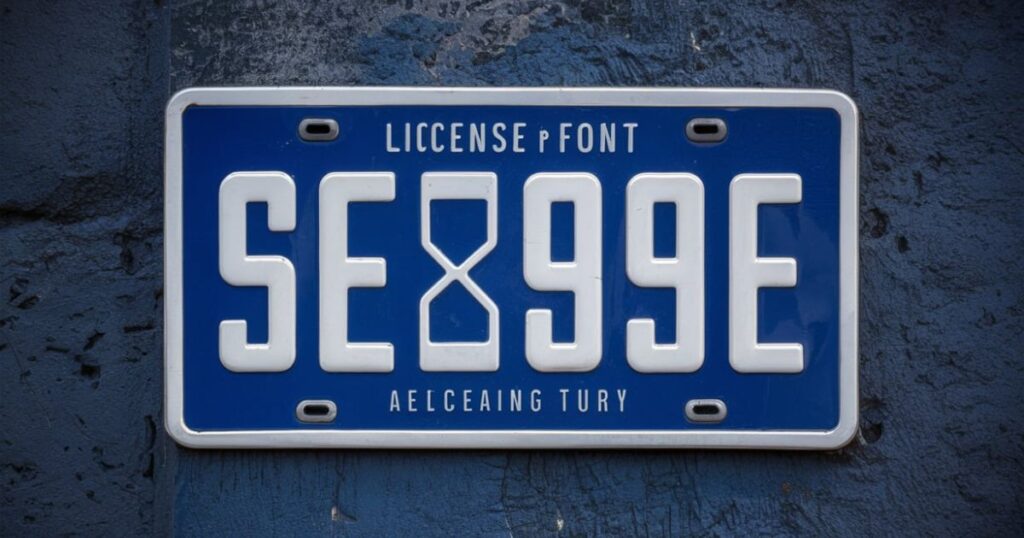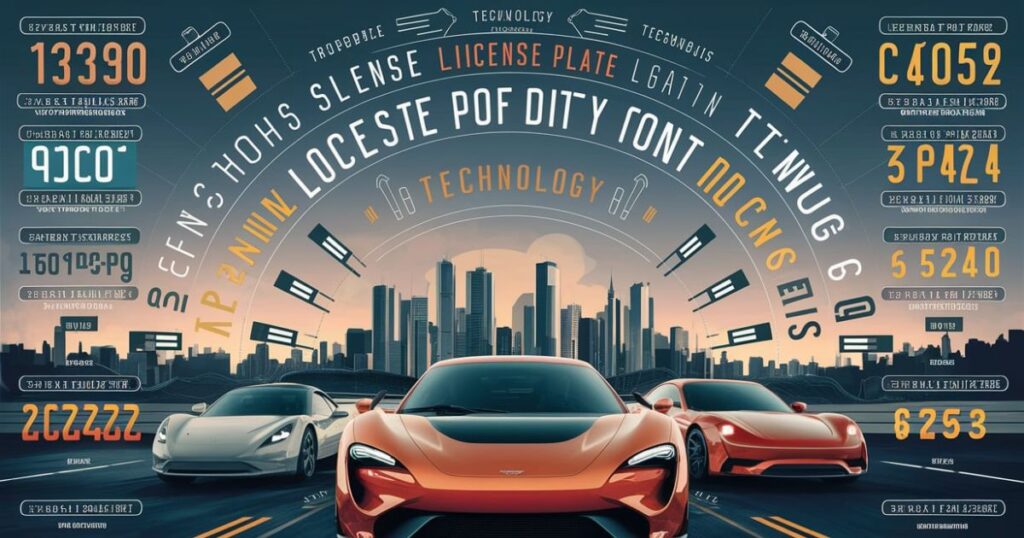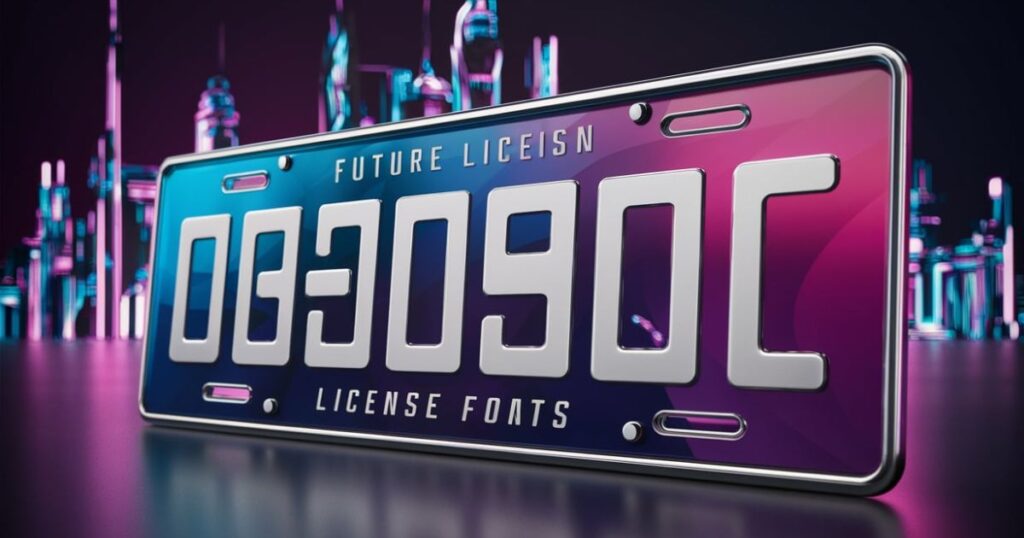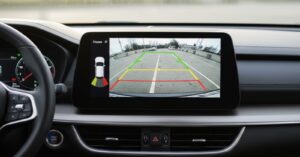A registration code font refers to the precise style and layout of letters and numbers used on automobile license plates. We carefully select these fonts for their readability and strong points, ensuring that characters are easily identifiable from a distance and in various situations. License plate fonts play a critical role in automobile identification, assisting law enforcement, automated structures, and everyday motorists in quickly and as it should be identifying automobiles on the street.
License plate fonts are more than simply letters and numbers they are designed for clarity and visibility. From simple shapes that prevent confusion to high-contrast colors for readability, every detail serves a purpose. These fonts ensure that human eyes and automated systems easily recognize license plates, ensuring protection and efficiency on the road.
A registration code font refers to the style of letters and numbers used on automobile plates. These fonts are cautiously designed for clarity from a distance and underneath extraordinary lighting conditions. They regularly function with simple, awesome characters to prevent confusion, along with between the number “zero” and the letter “O”. License plate fonts are critical for regulation enforcement, automated recognition structures, and public protection, making sure the brief and correct identity of cars on the road.
History of License Plate Fonts
The records of “License Plate Fonts” trace lower back to the early 20th century when vehicle registrations became large. Initially, license plates featured hand-painted or stamped numbers and letters, frequently in undeniable, utilitarian patterns. As the need for standardization grew, governments started out adopting particular fonts to improve legibility and decrease forgery.
By the mid-twentieth century, they introduced embossed characters and reflective substances, improving visibility. The evolution endured with virtual printing technology in the overdue 20th and early 21st centuries, bearing in mind greater tricky and secure font designs. Today, “License Plate Fonts” are cautiously crafted for clarity, safety, and aesthetic appeal.
Importance of Font Design in License Plates

The font layout in license plates plays a crucial role, as “License Plate Fonts” ensure clarity, security, and functionality. Clear, wonderful fonts beautify legibility from various distances and angles, aiding law enforcement and automatic systems in quickly identifying cars.
Proper font layout prevents misidentification by differentiating similar characters, consisting of “0” and “O” or “1” and “I”. Additionally, specialized fonts contain anti-counterfeiting functions, enhancing protection.
Common Fonts Used in License Plates Worldwide
License plate fonts vary globally, with each country often adopting specific styles to enhance readability and security. Common fonts used in international license plates include versions of DIN 1451. This font is popular in Germany and several other European countries. Another common font is FE-Schrift, designed to prevent tampering and improve legibility in various situations.
In the US, states typically use bespoke fonts that adhere to federal pointers for size and spacing, whilst also incorporating particular factors to distinguish country identification. These Idaho license plates are meticulously crafted to make sure they meet regulatory standards and are without difficulty recognizable through each person and automated structures.
How Font Impacts License Plate Legibility
The font used on license plates plays a crucial role in making sure that they are without problems readable from a distance, at numerous speeds, and below special light conditions. Legibility is vital for regulation enforcement, toll series, and typical road protection. Here’s an in-depth look at how font impacts license plate legibility:
Character Design and Clarity
Designers meticulously craft license plate fonts to ensure character design and clarity. They design each character with distinct, simple shapes to avoid confusion between similar-looking characters, such as ‘0’ and ‘O.’
- Distinctiveness: Fonts selected for license plates usually have awesome, simple shapes to prevent confusion among similar-searching characters. For example, the digit “0” and the letter “O” or the digit “1” and the letter “I” are designed to appear relatively one-of-a-kind.
- Stroke Width: Uniform stroke width in fonts helps preserve clarity, avoiding overly skinny or thick strokes that may be tough to read.
Size and Proportions
The size and proportions of license plate fonts are crucial for readability. Proper character height, width, and spacing ensure clarity from various distances and angles. Designers create license plate fonts to balance visibility and aesthetic appeal, facilitating brief recognition and decreasing the chance of misreading in exceptional situations.
- Height and Width: The length of the characters must be sufficient to be legible from a distance but not so big that they occupy an immoderate area. They carefully balance the share of man or woman height to width for the most reliable readability.
- Spacing: Proper spacing between characters (kerning) ensures that each letter and number is distinct and readable without blending into adjacent characters.
Visibility at Different Distances and Angles
Designers meticulously create license plate fonts to ensure visibility at different distances and angles. Clear and distinct characters are essential for readability from various viewpoints, whether up close or far away, and whether viewed head-on or at an angle, ensuring effective identification under diverse conditions.
- Distance Readability: The font should be without difficulty readable from diverse distances, which include near-up inspections and whilst viewed from numerous automobile lengths away.
- Angle of View: License plates must be legible from specific angles, making sure that the font is designed to keep away from distortion or lack of clarity when viewed from the facet or at a perspective.
Legibility at Speed
Designers create “License Plate Fonts” for top-of-the-line legibility at high speeds, ensuring that drivers and law enforcement can quickly and accurately read them even on fast-moving vehicles. Clear, distinct characters and proper spacing minimize motion blur, allowing for instant recognition and enhancing overall road safety.
- Quick Recognition: Drivers and law enforcement need you can speedy examine license plates, even at excessive speeds. Fonts are designed to be right away recognizable to keep away from misreading or misidentification.
- Minimizing Motion Blur: In certain fonts, designers reduce the consequences of motion blur, ensuring that characters stay clear and legible even when automobiles are in movement.
Custom and Vanity Plate Fonts
Custom and vanity plate fonts offer vehicle owners a unique opportunity to personalize their vehicles while adhering to the standard requirements of license plate fonts. These specialized fonts allow individuals to express their personalities, interests, or affiliations through distinctive lettering styles.
License plate fonts prioritize readability and regulatory compliance. Custom and vanity options provide design flexibility, incorporating creative elements and unconventional typographies. This customization enhances vehicle identity, featuring elegant cursive scripts to bold, modern fonts, while maintaining essential legibility and recognition for official identification on the road.
Security Features in License Plate Fonts

License plate fonts incorporate advanced security features to prevent counterfeiting and ensure authenticity. These fonts often integrate micro text, which is tiny, intricate text embedded within characters, making replication challenging. You may use holographic elements or specialized inks to create unique patterns that are difficult to reproduce.
Such security measures decorate the integrity of license plate fonts, safeguarding against unauthorized duplication and fraudulent sports. These capabilities are crucial for preserving the reliability of registration code identification systems. They aid regulation enforcement efforts and ensure the trustworthiness of “license plate fonts” for car identification.
Regional Variations in License Plate Fonts
Regional variations in “license plate fonts” reflect cultural diversity and regulatory preferences worldwide. Different countries and states often employ distinct fonts to reflect national identity or comply with specific visibility and security standards.
For instance, European nations prefer serif fonts for their classic appeal and readability. Many American states, on the other hand, choose sans-serif designs for their simplicity and modern look. These variations show how “license plate fonts” serve as both functional identifiers and cultural symbols. They adapt to local preferences and regulations while ensuring clarity and compliance with international standards.
The Evolution of Digital License Plate Fonts
The evolution of digital license plate fonts marks a significant advancement in transportation technology. These fonts leverage digital displays to offer dynamic visibility and enhanced customization options, revolutionizing traditional license plate designs. Unlike static embossed plates, digital formats can alter “license plate fonts” based on regulatory requirements or user preferences.
This flexibility extends to font size, style, and even language, accommodating diverse global standards and improving readability under varying conditions. Digital plates integrate advanced features such as real-time data updates and vehicle identification. These enhancements improve security and efficiency in modern traffic management systems. They also ensure compliance with evolving automotive regulations.
The Role of Technology in Designing License Plate Fonts

The design of license plate fonts has developed significantly with improvements in the era. The modern generation performs a critical role in developing fonts that are not only aesthetically beautiful but also fairly practical and steady. Here’s an in-depth study of how generation affects the layout of license plate fonts:
Computer-Aided Design (CAD) Software
Computer-aided design (CAD) software revolutionizes the creation of license plate fonts using presenting specific gear for designing and refining individual shapes, sizes, and spacing. This technology allows designers to meticulously craft fonts that ensure optimal readability and aesthetic appeal on license plates.
CAD allows for rapid prototyping and testing of various font styles. It ensures each character meets strict legibility standards under different lighting and environmental conditions. Designers use CAD software to achieve consistency and accuracy in license plate font designs, enhancing compatibility with modern OCR systems for automated identification.
Optical Character Recognition (OCR)
Optical Character Recognition (OCR) generation is vital for appropriately deciphering and deciphering registration code fonts. By digitally scanning and reading the characters on license plates, OCR structures can unexpectedly identify cars for numerous functions including law enforcement, toll collection, and visitor monitoring.
The readability and specialty of registration code fonts are crucial for OCR performance. Clean fonts facilitate fast and reliable information extraction from camera-captured images. This technology revolutionizes vehicle identification, integrating seamlessly into automated systems that interpret alphanumeric characters accurately in various conditions.
3D Printing and Prototyping
3D printing and prototyping revolutionize the development of license plate fonts with the aid of enabling fast generation and trying out. Designers utilize this technology to create bodily prototypes of license plates, experimenting with various font patterns, sizes, and substances to optimize clarity and aesthetic enchantment.
This technique lets in for brief changes based on real-global checking out, ensuring that license plate fonts preserve clarity and compliance with regulatory standards. Moreover, 3D printing helps the exploration of innovative designs and materials that beautify durability and visibility, marking a giant development in the evolution of registration code font layout.
Digital License Plates
Digital license plates constitute a transformative advancement in vehicle identification, integrating cutting-edge era with traditional license plate formats. These plates utilize dynamic displays to present crucial information, including customizable license plate fonts that can adapt to various conditions and preferences.
Unlike conventional plates, digital versions offer enhanced visibility and security features, leveraging innovative font designs that ensure readability under diverse environmental settings. License plate fonts on virtual plates can dynamically alter for foremost visibility, integrating with digital infrastructure for real-time updates and personalized statistics display.
Machine Learning and Artificial Intelligence (AI)
Machine-gaining knowledge of and synthetic intelligence (AI) have revolutionized the design and implementation of registration code fonts. AI algorithms analyze vast datasets to optimize font designs for readability, ensuring characters are easily recognizable by OCR systems and humans alike. These technologies enable real-time adjustments to font styles, enhancing legibility under varying conditions such as different lighting and viewing angles.
Furthermore, AI-driven insights aid in the development of fonts that integrate security features, thwarting counterfeiting attempts. By leveraging AI, license plate fonts are not simplest purposeful but also adaptive to technological improvements, making sure of efficient identity and improving avenue safety measures globally.
Security and Anti-Counterfeiting Technologies
License plate fonts are integral to modern security and anti-counterfeiting technologies. These fonts incorporate intricate designs and features that deter unauthorized replication and ensure the authenticity of license plates. Advanced printing techniques embed security elements directly into the font, such as micro text and holographic patterns, making it difficult to counterfeit or alter plates illegally.
By employing unique fonts and patterns that are challenging to replicate, authorities can enhance the overall security of vehicle identification systems. This technological approach safeguards against fraud and ensures that license plates serve their crucial role in law enforcement and public safety effectively.
User-Centered Design
The user-centered layout inside the context of license plate fonts prioritizes the desires and preferences of give-up-users, inclusive of law enforcement officials and the general public. This method ensures that fonts are not handiest visually attractive but also pretty legible in diverse situations together with extraordinary lighting fixtures and weather eventualities.
By gathering comments and integrating personal insights early inside the layout method, designers can create registration code fonts that optimize readability and simplicity of identity. User-centered layout principles emphasize usability and capability, aiming to beautify the general experience of interacting with license plates whilst meeting stringent necessities for clarity and visible difference.
Environmental Considerations
License plate fonts are increasingly designed with environmental concerns in mind, aiming to decrease their ecological effect. Innovations recognize sustainable substances for each traditional and virtual license plate, ensuring durability without compromising clarity. Technologies allow the usage of green inks and materials that reduce environmental footprint during production and in the course of the plate’s lifecycle.
Additionally, energy-efficient designs are crucial for digital license plates, optimizing font visibility while conserving power. By integrating those environmental concepts into license plate font layout, the government and producers can contribute to a greater sustainable transportation infrastructure without compromising on the plates’ practical and aesthetic features.
Future Trends in License Plate Font Design

In the realm of license plate fonts, future tendencies are poised to revolutionize both aesthetics and functionality. Advancements in generation, consisting of AI-pushed layout optimization and the combination of digital plates, will probably lead to extra dynamic and adaptable registration code fonts.
These fonts will prioritize enhanced readability under various environmental conditions, ensuring clarity for automated recognition systems. Moreover, customizable options may become more prevalent, allowing users to personalize their plates while maintaining compliance with regulatory standards. As urbanization and digitalization accelerate, the evolution of license plate fonts will play a crucial role in shaping vehicle identification and security protocols globally.
Conclusion
In conclusion, license plate fonts are more than just stylistic choices; they are pivotal elements in vehicle identification systems worldwide. Designed for maximum legibility and functionality, these fonts undergo meticulous consideration of factors like character clarity, size, and contrast against the plate background. As technology advances, from computer-aided design to digital plate innovations, the future promises even more adaptable and secure font solutions.
The evolution of license plate fonts reflects ongoing efforts to enhance traffic safety, streamline law enforcement processes, and integrate with automated recognition systems seamlessly. Whether in traditional or digital formats, the importance of clear and distinct license plate font remains paramount, ensuring efficient vehicle identification and contributing to overall road security and management in an increasingly connected world.
FAQs
What is a license plate font?
A license plate font refers to the specific style of letters and numbers used on vehicle plates.
Why are license plate fonts important?
They are crucial for ensuring the quick and accurate identification of vehicles for law enforcement and automated systems.
How are license plate fonts designed?
They are designed to be highly legible from a distance, under various lighting conditions, and to prevent character confusion.
Can license plate fonts be customized?
Yes, some regions allow customization of license plate fonts for personalization within regulatory guidelines.
What role does technology play in license plate font design?
Technology enables precise design, testing for readability, and integration with digital and security features to enhance functionality.









